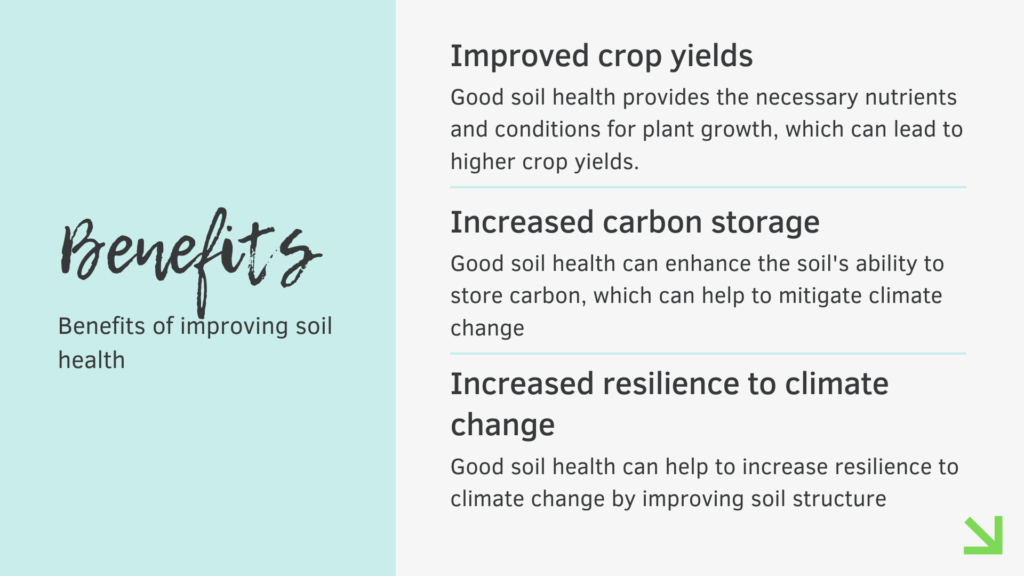Contact: +91 99725 24322 |
Menu
Menu
Quick summary: Discover the crucial role of soil health in regenerative agriculture. Learn how healthy soil can improve crop yields, increase carbon sequestration, enhance biodiversity and reduce the impact of climate change. Explore the benefits of regenerative practices that promote soil health and create a sustainable future for agriculture.

Did you know that our planet’s soil is rapidly deteriorating? According to UN, approximately 33% of global soils are already degraded and this degradation is accelerating. This is of a grave concern as soil forms the sustenance of life on earth. Soil is not only crucial for food production but also helps to mitigate effects of climate change. Soil regenerative agriculture is a set of farming practices that focus on building healthy soils, promoting biodiversity, and enhancing ecosystem services. Regenerative farming seeks to improve soil health by using practices such as reduced tillage, cover cropping, crop rotations, and the use of compost and other organic amendments.
The goal of soil regenerative farming is to create a healthy soil ecosystem that can support plant growth, nutrient cycling, carbon sequestration, and other ecosystem services. Regenerative farming practices aim to mimic natural ecosystems, promoting soil health and biodiversity while minimizing the negative impacts of conventional agriculture on soil health and the environment. This blog aims to cover the broader topics of soil regenerative farming. With the understanding of principles of regenerative and sustainable farming, the understanding soil health and then relating regenerative and sustainable practices and how can regenerative farming practices help increase soil health.
Regenerative farming practices can help to build soil organic matter, improve soil structure, and increase soil water-holding capacity, which can improve crop productivity, reduce erosion, and mitigate the impacts of drought and flooding. By promoting soil health and biodiversity, regenerative farming practices can also help to support ecosystem services such as pollination, pest control, and carbon sequestration.
Regenerative Agriculture is based upon a philosophy that seeks to replicate the structure and function that is equivalent natural systems in the design similar to biologically healthy and resilient farm systems. Regenerative farming requires a mindset that is structured, systems-based, place-based, and positive-outcome oriented. Regenerative design is approach where the output of a system improves the health and resiliency of that system over the time. Furthermore, Regenerative agriculture is a farming practice that embraces the principles of sustainability and aims to restore the degraded farmland back to a state of health while sustaining its land-based income to those who depend on it for their livelihood. This practice has been gaining popularity among farmers and consumers alike, as it offers a more natural approach to agriculture that is not only beneficial to the environment but also helps to improve the productivity and resilience of farms.
By keeping the soil rich and healthy, regenerative agriculture can create healthy food for consumers to eat. Regenerative agriculture is not just about reducing harm – but seeks to improve the health of the land, waterways, the animals that live on it, and people that benefit from it. As our population expands and demand for resources increases so too do the strains of acquiring our resources in ways that blend in with the natural function of ecosystems. The sustainable production of resources must ultimately be blended in with sustaining healthy natural ecosystems.
Regenerative agriculture platforms support the growth of a more sustainable and equitable food system, while also mitigating climate risk and improving supply chain resilience.
Soil health refers to the capacity of soil to function as a living ecosystem that supports plant growth, nutrient cycling, carbon sequestration, and other ecosystem services. It is essential to maintain soil health as it plays a vital role in sustaining human life by providing the foundation for food production, clean water, and air. Soil health can be measured by assessing its physical, chemical, and biological properties.
Physical properties of soil include its texture, structure, and water-holding capacity. The texture of soil refers to the size of the individual mineral particles that make up the soil, such as sand, silt, and clay. The structure of soil refers to how these particles are arranged and held together, which affects water movement, aeration, and root growth. The water-holding capacity of soil refers to how much water it can hold and release to plants.
Chemical properties of soil refer to the nutrients and minerals that are present in the soil, such as nitrogen, phosphorus, and potassium, as well as the pH level, which affects the availability of these nutrients. Soil microorganisms, including bacteria, fungi, and protozoa, are essential for converting organic matter into nutrients that plants can use.
Biological properties of soil include the diversity and abundance of microorganisms, insects, and other organisms that live in the soil. These organisms are responsible for decomposing organic matter, cycling nutrients, and maintaining the physical structure of soil.
Maintaining soil health is critical for sustainable agriculture
and ecosystem health. Soil degradation, which can result from activities such as overuse of pesticides and fertilizers, erosion, and deforestation, can lead to decreased soil fertility, reduced crop yields, and degraded water quality. Soil conservation practices such as cover cropping, crop rotation, and reduced tillage can help to maintain and improve soil health.
There are several key indicators of soil health, including:
Overall, soil health is important for agricultural productivity, ecosystem health, and climate resilience. By prioritizing soil health through practices such as cover cropping, reduced tillage, and the use of organic amendments, farmers can build healthy and resilient soil ecosystems that support sustainable and productive agriculture.
Soil health is a complex and dynamic concept that is influenced by various factors. Some of the primary factors that affect soil health are:

Good soil health is essential for sustainable agriculture and a healthy ecosystem. Soil is a vital natural resource that supports plant growth, filters and stores water, stores carbon, and provides habitat for a wide range of organisms. Soil management is beneficial for agriculture
TraceX has been working with farmer communities driving sustainable practices in agriculture. Soil health that forms a basis for regenerative agriculture practices is a high impact indicator that needs to be captured. Soil health indicators are measured as a part of the Farm management solutions that TraceX offers. This helps in tracking the sustainable practices followed and gives real-time insights to take informed decisions.
Conclusion
Good soil health is essential for sustainable agriculture, a healthy ecosystem, and a resilient planet. By promoting good soil health through practices such as conservation tillage, crop rotation, and cover cropping, we can enhance the productivity of our agricultural systems, protect water resources, reduce erosion, and support biodiversity. Maintaining soil health requires a holistic approach that considers the physical, chemical, and biological properties of soil, and the complex interactions between these properties. By implementing soil conservation practices and promoting sustainable land use practices, we can ensure that our soil remains healthy and productive for generations to come.
Let us remember that healthy soil is the basis of all life on our planet.
